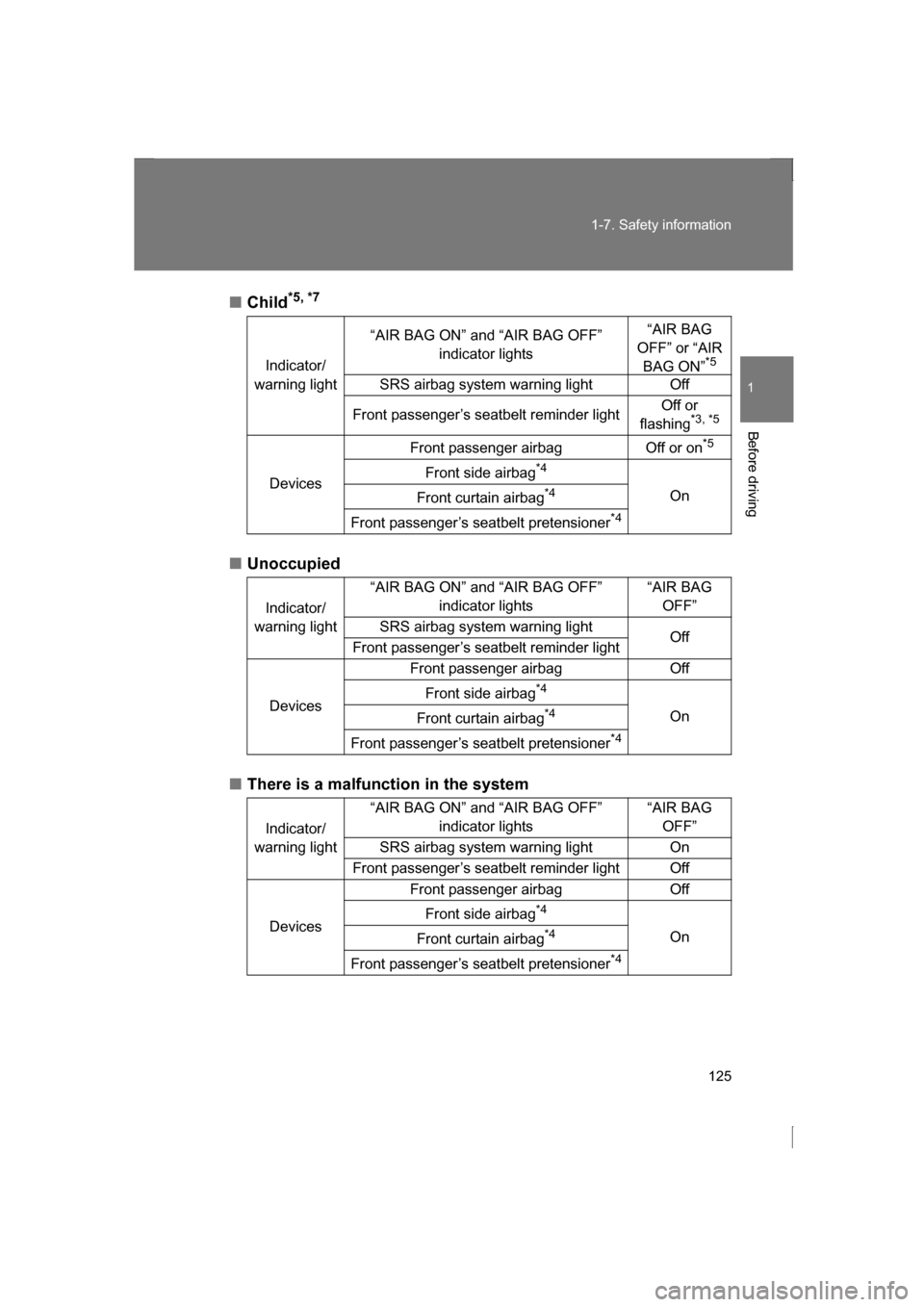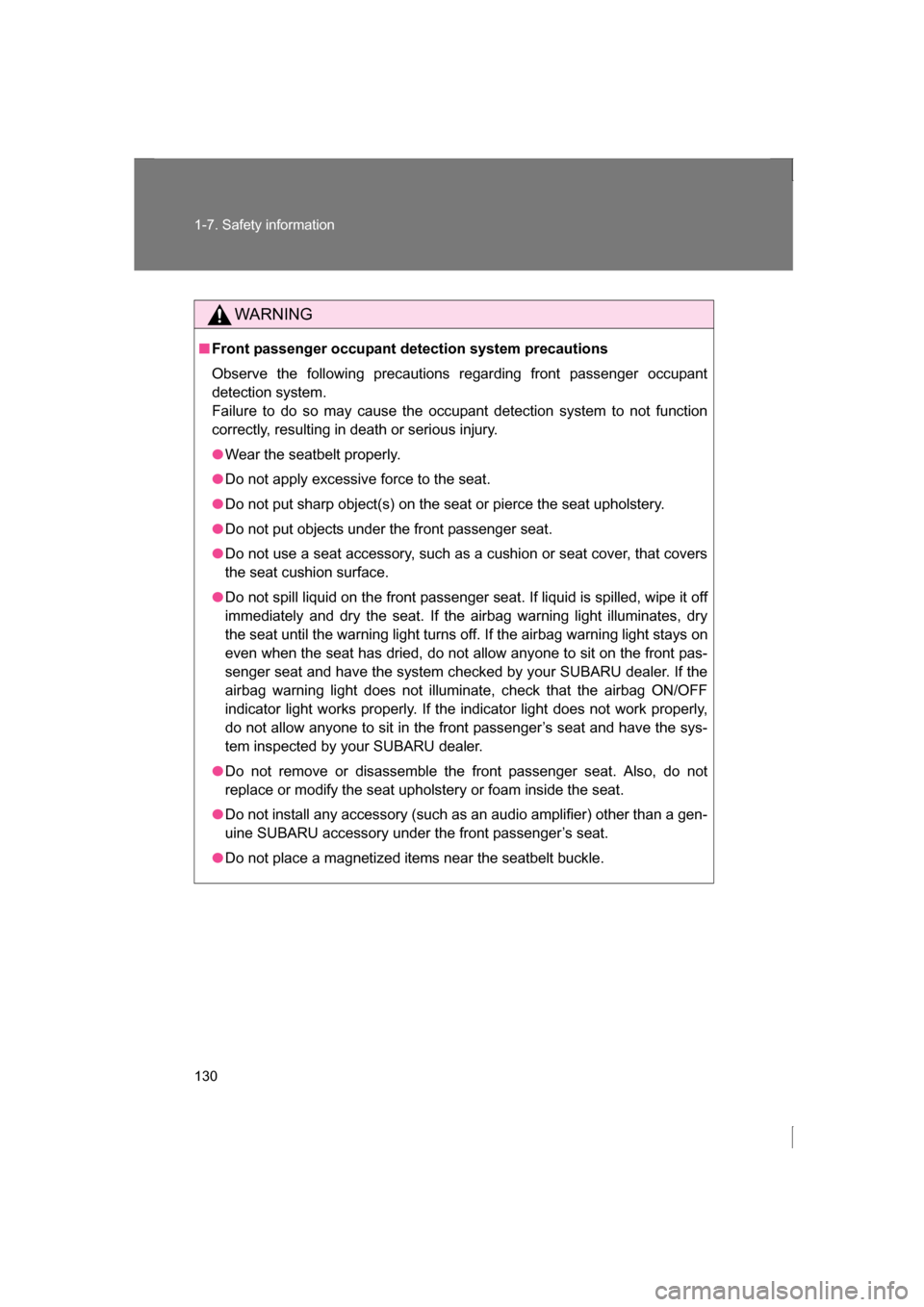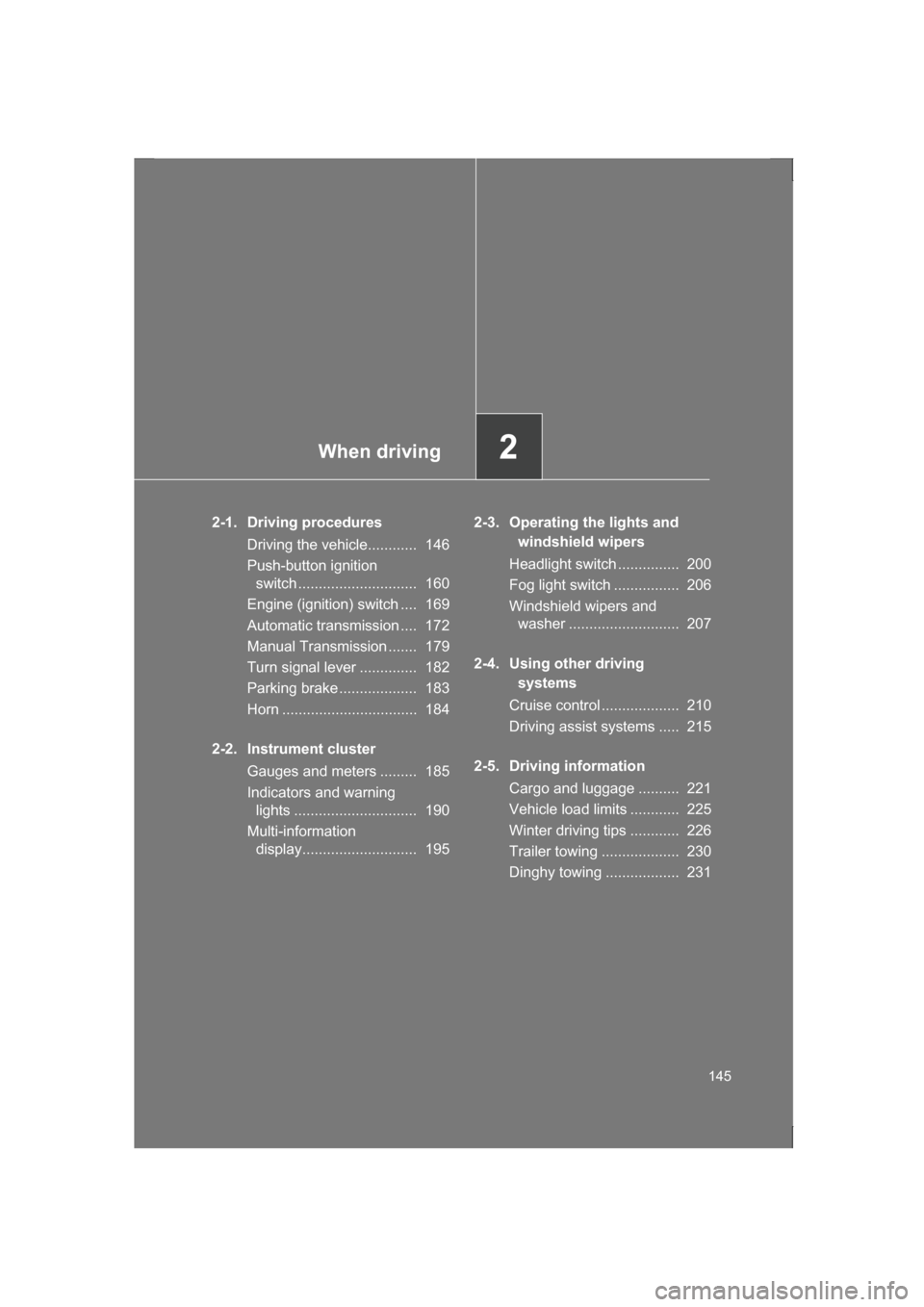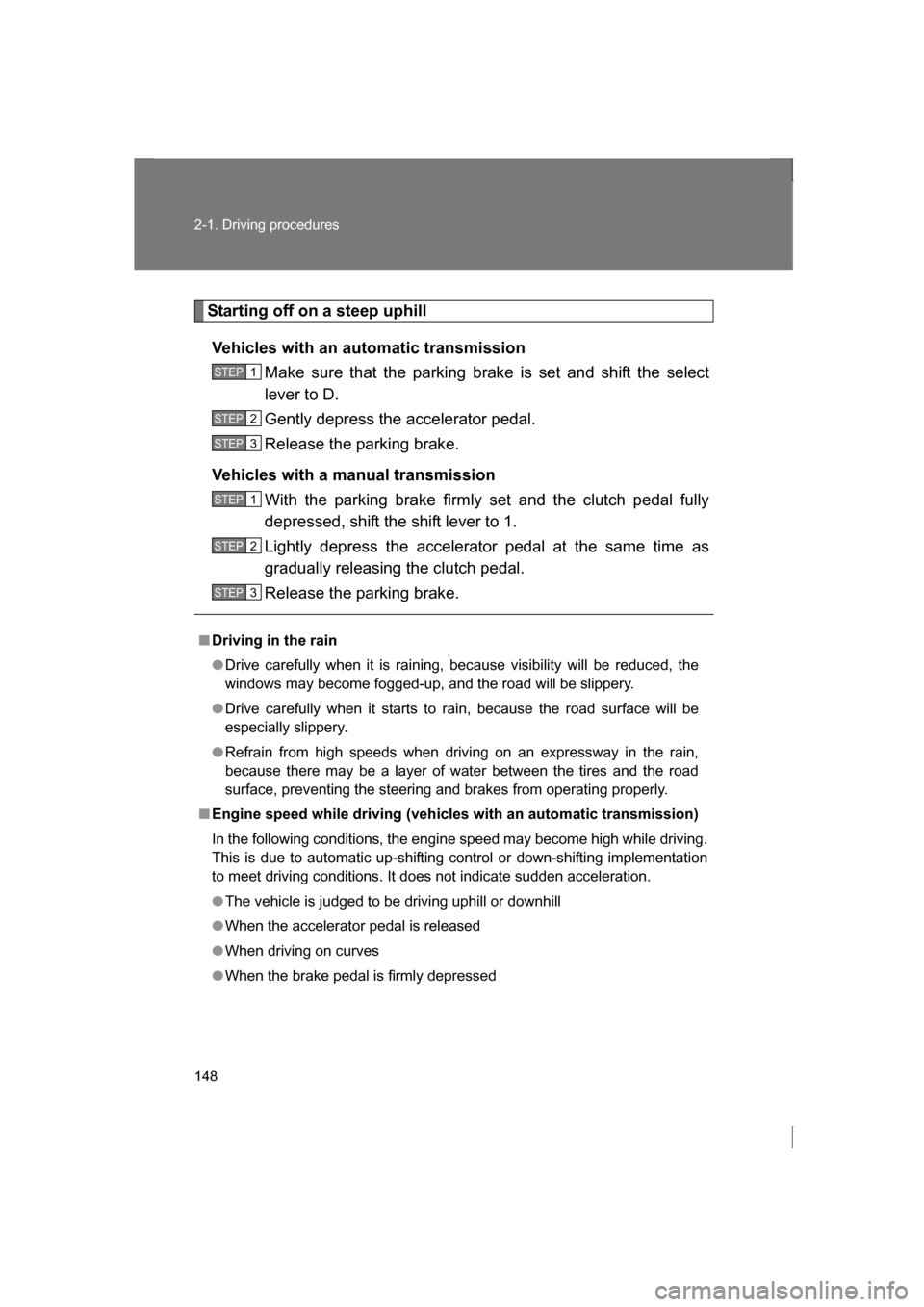Page 124 of 484
124
1-7. Safety information
Condition and operation in the front passenger occupant
detection system*1
■Adult*2
■Child restraint system with infant *6, *7, *8
Indicator/
warning light “AIR BAG ON” and “AIR BAG OFF”
indicator lights “AIR BAG
ON”
SRS airbag system warning light Off
Front passenger’s seatbelt reminder light Flashing*3
Devices Front passenger airbag
On
Front side airbag
*4
Front curtain airbag *4
Front passenger’s seatbelt pretensioner *4
Indicator/
warning light “AIR BAG ON” and “AIR BAG OFF”
indicator lights “AIR BAG
OFF” *9
SRS airbag system warning light Off
Front passenger’s seatbelt reminder light
Devices Front passenger airbag Off
Front side airbag *4
On
Front curtain airbag *4
Front passenger’s seatbelt pretensioner *4
Page 125 of 484

125
1-7. Safety information
1
Before driving
■Child*5, *7
■Unoccupied
■There is a malfunction in the systemIndicator/
warning light “AIR BAG ON” and “AIR BAG OFF”
indicator lights “AIR BAG
OFF” or “AIR BAG ON” *5
SRS airbag system warning light Off
Front passenger’s seatbelt reminder light Off or
flashing *3, *5
Devices Front passenger airbag Off or on
*5
Front side airbag *4
On
Front curtain airbag *4
Front passenger’s seatbelt pretensioner *4
Indicator/
warning light “AIR BAG ON” and “AIR BAG OFF”
indicator lights “AIR BAG
OFF”
SRS airbag system warning light Off
Front passenger’s seatbelt reminder light
Devices Front passenger airbag Off
Front side airbag *4
On
Front curtain airbag *4
Front passenger’s seatbelt pretensioner *4
Indicator/
warning light “AIR BAG ON” and “AIR BAG OFF”
indicator lights “AIR BAG
OFF”
SRS airbag system warning light On
Front passenger’s seatbelt reminder light Off
Devices Front passenger airbag Off
Front side airbag *4
On
Front curtain airbag *4
Front passenger’s seatbelt pretensioner *4
Page 130 of 484

130
1-7. Safety information
WARNING
■Front passenger occupant detection system precautions
Observe the following precautions regarding front passenger occupant
detection system.
Failure to do so may cause the occupant detection system to not function
correctly, resulting in death or serious injury.
●Wear the seatbelt properly.
●Do not apply excessive force to the seat.
●Do not put sharp object(s) on the seat or pierce the seat upholstery.
●Do not put objects under the front passenger seat.
●Do not use a seat accessory, such as a cushion or seat cover, that covers
the seat cushion surface.
●Do not spill liquid on the front passenger seat. If liquid is spilled, wipe it off
immediately and dry the seat. If the airbag warning light illuminates, dry
the seat until the warning light turns off. If the airbag warning light stays on
even when the seat has dried, do not allow anyone to sit on the front pas-
senger seat and have the system checked by your SUBARU dealer. If the
airbag warning light does not illuminate, check that the airbag ON/OFF
indicator light works properly. If the indicator light does not work properly,
do not allow anyone to sit in the front passenger’s seat and have the sys-
tem inspected by your SUBARU dealer.
●Do not remove or disassemble the front passenger seat. Also, do not
replace or modify the seat upholstery or foam inside the seat.
●Do not install any accessory (such as an audio amplifier) other than a gen-
uine SUBARU accessory under the front passenger’s seat.
●Do not place a magnetized items near the seatbelt buckle.
Page 145 of 484

When driving2
145
2-1. Driving proceduresDriving the vehicle............ 146
Push-button ignition switch ............................. 160
Engine (ignition) switch .... 169
Automatic transmission .... 172
Manual Transmission ....... 179
Turn signal lever .............. 182
Parking brake ................... 183
Horn ................................. 184
2-2. Instrument cluster Gauges and meters ......... 185
Indicators and warning lights .............................. 190
Multi-information display............................ 195 2-3. Operating the lights and
windshield wipers
Headlight switch ............... 200
Fog light switch ................ 206
Windshield wipers and washer ........................... 207
2-4. Using other driving systems
Cruise control ................... 210
Driving assist systems ..... 215
2-5. Driving information Cargo and luggage .......... 221
Vehicle load limits ............ 225
Winter driving tips ............ 226
Trailer towing ................... 230
Dinghy towing .................. 231
Page 148 of 484

148
2-1. Driving procedures
Starting off on a steep uphillVehicles with an automatic transmission Make sure that the parking brake is set and shift the select
lever to D.
Gently depress the accelerator pedal.
Release the parking brake.
Vehicles with a manual transmission With the parking brake firmly set and the clutch pedal fully
depressed, shift the shift lever to 1.
Lightly depress the accelerator pedal at the same time as
gradually releasing the clutch pedal.
Release the parking brake.
■Driving in the rain
●Drive carefully when it is raining, because visibility will be reduced, the
windows may become fogged-up, and the road will be slippery.
●Drive carefully when it starts to rain, because the road surface will be
especially slippery.
●Refrain from high speeds when driving on an expressway in the rain,
because there may be a layer of water between the tires and the road
surface, preventing the steering and brakes from operating properly.
■Engine speed while driving (vehicl es with an automatic transmission)
In the following conditions, the engine speed may become high while driving.
This is due to automatic up-shifting c ontrol or down-shifting implementation
to meet driving conditions. It does not indicate sudden acceleration.
●The vehicle is judged to be driving uphill or downhill
●When the accelerator pedal is released
●When driving on curves
●When the brake pedal is firmly depressed
STEP 1
STEP 2
STEP 3
STEP 1
STEP 2
STEP 3
Page 149 of 484
![SUBARU BRZ 2013 1.G Owners Manual 149
2-1. Driving procedures
2
When driving
■New vehicle break-in driving (the first 1000 miles [1600 km])
The performance and long life of your vehicle are dependent on how you
handle and care for SUBARU BRZ 2013 1.G Owners Manual 149
2-1. Driving procedures
2
When driving
■New vehicle break-in driving (the first 1000 miles [1600 km])
The performance and long life of your vehicle are dependent on how you
handle and care for](/manual-img/17/7178/w960_7178-148.png)
149
2-1. Driving procedures
2
When driving
■New vehicle break-in driving (the first 1000 miles [1600 km])
The performance and long life of your vehicle are dependent on how you
handle and care for your vehicle while it is new. Follow these instructions
during the first 1000 miles (1600 km):
●Do not allow the engine speed to exceed 4000 rpm except in an emer-
gency.
●Do not drive at one constant engine or vehicle speed for a long time,
either fast or slow.
●Avoid starting suddenly and rapid acceleration, except in an emergency.
●Avoid hard braking, except in an emergency.
The same break-in procedures should be applied to an overhauled engine,
newly mounted engine or when brake pads or brake linings are replaced
with new ones.
■Replacement of brake pad and lining
The front disc brake and the rear disc brake have audible wear indicators on
the brake pads. If the brake pads wear close to their service limit, the wear
indicator makes a very audible scraping noise when the brake pedal is
applied.
■Breaking-in of new brake pads and linings
When replacing the brake pad or li ning, use only genuine SUBARU parts.
After replacement, the new parts must be broken in as follows.
Brake pad and lining
While maintaining a speed of 30 to 40 mph (50 to 65 km/h), step on the
brake pedal lightly. Repeat this five or more times. If you hear this scraping noise each time
you apply the brake pedal, have the
brake pads serviced by your SUBARU
dealer as soon as possible.
Page 153 of 484

153
2-1. Driving procedures
2
When driving
WARNING
●Always check that all passengers' arms, heads or other parts of their body
are not outside the vehicle, as this may result in death or serious injury.
●Do not drive in excess of the speed limit. Even if the legal speed limit per-
mits it, do not drive over 85 mph (140 km/h) unless your vehicle has high-
speed capability tires. Driving over 85 mph (140 km/h) may result in tire
failure, loss of control and possible injury. Be sure to consult a tire dealer
to determine whether the tires on your vehicle are high-speed capability
tires or not before driving at such speeds.
■When driving on slippery road surfaces
●Sudden braking, acceleration and steering may cause tire slippage and
reduce your ability to control the vehicle, resulting in an accident.
●Sudden acceleration, engine braking due to shift changing, or changes in
engine speed could cause the vehicle to skid, resulting in an accident.
●After driving through a puddle, lightly depress the brake pedal to make
sure that the brakes are functioning properly. Wet brake pads may prevent
the brakes from functioning properly. If the brakes on only one side are wet
and not functioning properly, steering control may be affected, resulting in
an accident.
■When shifting the select lever or shift lever
●On vehicles with an automatic transmission, be careful not to shift the
select lever with the accelerator pedal depressed. Shifting the select lever
to a gear other than P or N may lead to unexpected rapid acceleration of
the vehicle that may cause an accident and result in death or serious
injury.
●Do not place items in the select lever’s or shift lever’s surrounding area. It
may cause incorrect operation.
●If the select lever’s or shift lever’s boot is pulled out during cleaning, return
it to its previous position. If the select lever’s or shift lever’s boot is left
pulled out, the select lever or shift lever may become difficult to operate.
Page 155 of 484
155
2-1. Driving procedures
2
When driving
WARNING
■When the vehicle is parked
●Do not leave glasses, cigarette lighters, spray cans, or soft drink cans in
the vehicle when it is in the sun.
Doing so may result in the following: